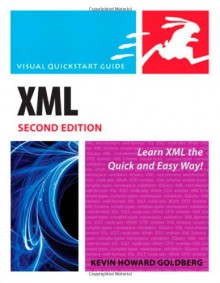What is XML? XML, or eXtensible Markup Language, is a specification for storing information. It is also a specification for describing the structure of that information. And while XML is a markup language (just like HTML), XML has no tags of its own. It allows the person writing the XML to create...
show more
What is XML? XML, or eXtensible Markup Language, is a specification for storing information. It is also a specification for describing the structure of that information. And while XML is a markup language (just like HTML), XML has no tags of its own. It allows the person writing the XML to create whatever tags they need. The only condition is that these newly created tags adhere to the rules of the XML specification.In the seven years since the first edition of “XML: Visual QuickStart Guide” was published, XML has taken its place next to HTML as a foundational language on the Internet. XML has become a very popular method for storing data and the most popular method for transmitting data between all sorts of systems and applications. The reason being, where HTML was designed to display information, XML was designed to manage it.This book begins by showing you the basics of the XML language. Then, by building on that knowledge, additional and supporting languages and systems will be discussed. To get the most out of this book, you should be somewhat familiar with HTML, although you don’t need to be an expert coder by any stretch. No other previous knowledge is required. “XML: Visual QuickStart Guide, 2nd Edition” is divided into seven parts. Each part contains one or more chapters with step-by-step instructions that explain how to perform XML-related tasks. Wherever possible, examples of the concepts being discussed are displayed, and the parts of the examples on which to focus are highlighted. The order of the book is intentionally designed to be an introduction to the fundamentals of XML, followed by discussions of related XML technologies. • In Part 1 of the book, you will learn how to create an XML document. It’s relatively straightforward, and even more so if you know a little HTML. • Part 2 focuses on XSL, which is a set of languages designed to transform an XML document into something else: an HTML file, a PDF document, or another XML document. Remember, XML is designed to store and transport data, not display it. • Parts 3 and 4 of the book discuss DTD and XML Schema, languages designed to define the structure of an XML document. In conjunction with XML Namespaces (Part 5), you can guarantee that XML documents conform to a pre-defined structure, whether created by you or by someone else. • Part 6, Developments and Trends, details some of the up-and-coming XML-related languages, as well as a few new versions of existing languages. • Finally, Part 7 identifies some well-known uses of XML in the world today; some of which you may be surprised to learn. This beginner’s guide to XML is broken down as follows: • Introduction • Chapter 1: Writing XML • Part 2: XSL • Chapter 2: XSLT • Chapter 3: XPath Patterns and Expressions • Chapter 4: XPath Functions • Chapter 5: XSL-FO • Part 3: DTD • Chapter 6: Creating a DTD • Chapter 7: Entities and Notations in DTDs • Chapter 8: Validation and Using DTDs • Part 4: XML Schema • Chapter 9: XML Schema Basics • Chapter 10: Defining Simple Types • Chapter 11: Defining Complex Types • Part 5: Namespaces • Chapter 12: XML Namespaces • Chapter 13: Using XML Namespaces • Part 6: Recent W3C Recommendations • Chapter 14: XSLT 2.0 • Chapter 15: XPath 2.0 • Chapter 16: XQuery 1.0 • Part 7: XML in Practice • Chapter 17: Ajax, RSS, SOAP and More
show less

